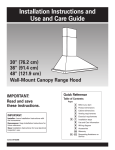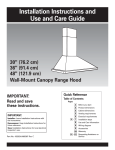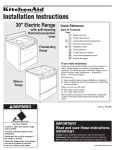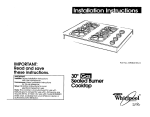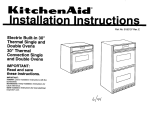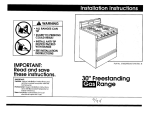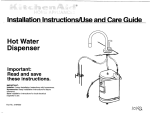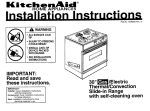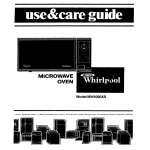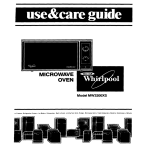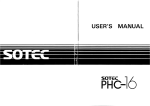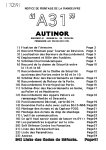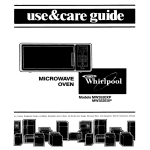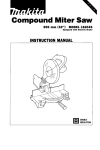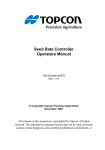Download KitchenAid 9750520 REV A User's Manual
Transcript
KiitchenAPd I Qn I InstruCtIons Part No. 9750520 Rev A 30” Electric Freestanding Range IMPORTANT: Read and save these instructions. IMPORTANT: Installer: Leave Installation Instructions with the homeowner. Homeowner: Keep Installation Instructions for future reference. Save Installation Instructions for local electrical inspector’s use. Check location where range will be installed. The range should be located for convenient use in kitchen. ALL OPENINGS IN THE WALL OR FLOOR WHERE RANGE IS TO BE INSTALLED MUST BE SEALED. Important: Observe all governlng codes and ordinances. 13” max. upper ~13” Proper installation is your responsibility. A qualified technician should install this range. Make sure you have everything necessary for correct installation. It is the responsibility of the installer to comply with installation clearances specified on the serial/rating plate. The max upper cabinet cabinet Before you start... ~ serial/rating plate is located on the oven frame depth +- depth For minimum clearance, Personal Injury Hazard Avoid installing cabinet storage above the cooking surface. If cabinets are already Installed, reduce the hazard of reaching over a heated cooking surface by Installing a range hood. The range hood should extend a minimum of 5 inches out from the bottom front of the cabinets. Reaching over a heated cooking surface could result in a serious burn or other personal injury. Electrical Shock Hazard It is the customer’s responsibility: To contact a qualified electrical installer. To assure that the electrical installation Is adequate and in conformance with National Electrical Code, ANSVNFPA 70-latest edition**, and all local codes and ordinances. Failure to do so could result in fire, electrical shock or other personal injury. 4” Min. . . see “:rcounrenop 1 . 18” min. clearance upper cabinet to countertop. 30-3/8” openlng wldth / I Wall receptacle 6” to 22” fron elther cablne 7” max. from floor. +y l I I 36” countertop helght I I I I l /////’ o Not pinch 18 power cord between the ran e and the wal ?. I ., ’ \ Grounded electricil\ outlet is reauired. See Electric’al requirements. , \ \ L \\ / .I \ \ Mobile home installation Do Not seal the range to the slde cabinets. \ -JY NOTE: Clearances specified are for combustible walls and materials that have a density of 20 or more pounds per cubic foot. No evaluation of clearances has been made for installations adjacent to materials that are less than 20 pounds per cu. ft. or to plastic tile or sheeting. t The an&tip bracket MUST be Installed. For detalled lnstructlons. see Panels B and C. Cablnet opening dimensions that are shown must be used. Given dimensions are minimum clearances and provide required 0” clearance. Tools needed for installation: *Note: 24” mln. when bottom of or metal cabinet Is protected by less than 114” flame retardant mlllboard covered wlth not less No. 26 MSG sheet steel, 0.015” stalnless steel, 0.024” alumlnum 0.020” copper. 30” mln. clearance between the of the cooklng platform and the bottom of an unprotected wood metal cabinet. Electrical requirements Save Installation Instructions for the local electrical inspector’s use. Power cord is not supplied but is available through you local electrical supply houses. Electrlcal Shock Hazard . Electrical ground is required on thls appliance. Improper connection of the equipmentgrounding conductor can result in electrical shock. Check with a qualified electrician if you are in doubt as to whether the appliance is properly grounded. Only a power supply cord kit rated at 250 volts, 40 amperes and investigated for use with ranges should be used. Do Not have a fuse in the neutral or grounding circuit. A fuse in the neutral or grounding circuit could result in electrical shock. Do Not plug the “pigtail” power cord into a live wall receptacle before the cord Is permanently connected to the terminal block. To do so may result in personal injury from electrical shock. Failure to follow these instructions could result in a fire, electrical shock or personal injury. l hand or electric drill wood/metal wall stud: l/B-Inch drill blt concrete/concrete block walls: 3116.Inch carblde-tlpped masonry drill blt l l Parts supplied installation: for 2 screws (#lo x l-112”) (Thickness of wall coverln may requlre longer screws, ava 9 lable from you local hardware store.) :ket 2 plastic Panel A the oven door. behind anchors l l wood not than or top or The installation of this range must conform to the Manufactured Home Construction and Safety Standards, Title 24 CFR, Part 3280 (formerly the Federal Standard for Mobile Home Construction and Safety, Title 24, HUD, Part 280); or when such standard is not applicable, the Standard for Manufactured Homes Installations 1982 (Manufactured Home Sites, Communities and Setups), ANSI A2251 1987, or latest edition*‘, or with local codes. When this range is installed in a mobile home, it must be secured to the floor during transit. Any method of securing the range is adequate as long as it conforms to the standards listed above. Four-wire power supply cable must be used in a mobile home installation. The appliance wiring will need to be revised. See 4-wire electrical connection, Panel C. Copies of the standards listed may be obtained from: **National Fire Protection Association Batterymarch Park Quincy, Massachusetts 02269 (A/ . A three-wire or a four-wire single phase, 120/240-volt, 60-Hz, AC-only, electrical supply (or three-wire or four-wire 120/208-volt if specified on serial plate) is required on a separate 40-ampere circuit, fused on both sides of the line. A time-delay fuse or circuit breaker is recommended. THE RANGE MUST BE CONNECTED WITH COPPER WIRE ONLY. /c.( Local codes may permit the use of a U.L.-listed, 250-volt, 40-ampere range power supply cord (pigtail). This cord’ contains three, No.-1 0 copper wires and matches a threewire receptacle of NEMA Type 1O-50R, shown in Figure 1. Connectors on the appliance end must be ring terminals. A U.L.-listed strain relief must be provided at the point the power supply cord enters the appliance. ID.I The appliance should be connected directly to the fused disconnect or circuit breaker box through flexible, armored or non-metallic sheathed, copper cable. Allow two or three feet of slack in the line so that it can be moved if servicing is ever necessary. A U.L.-listed conduit connector must be provided at each end of the power supply cable (at the appliance and at the junction box). Wire sizes (COPPER WIRE ONLY) and connections must conform with the rating of the appliance (40 amperes). centerline 3-wire electrical connection /E IF CONNECTING TO A 4-WIRE ’ ELECTRICAL SYSTEM: This aooliance is manufactured with ground connected ii cabinet. The ground must be revised so the green grounding wire of the 4-wire power cord is connected to the cabinet. See 4-wire electrical connection section, Panel C. When a 4-wire receptacle of NEMA type 14-50R is used (See Figure 2), a matching U.L.-listed, 4wire, 250-volt, 40-ampere, range power supply cord (pigtail) must be used. This cord contains four copper conductors with ring terminals on the appliance end, terminating in a NEMA Type 1450P plug on the supply end. The fourth (grounding) conductor must be identified by a green or green/yellow cover and the neutral conductor by a white cover. Cord should be Type SRD or SRDT with a U.L.-listed strain relief and be at least four feet long. The MINIMUM conductor sizes for the copper 4wire power cord are: 40 ampere circuit 2, No.-8 conductors 1, No.-1 0 white neutral 1, No.-8 green grounding EJ The wiring diagram is also located on the back of the range. n See Panel C for 4-wire electrical connection. Knock-out opening for 40.amDere Dower % 7I Conduit connector opening U.L. listed conduit connector \ If appliance is to be connected directly to fused disconnect or circuit breaker b&x: Assemble a U.L.-listed conduit connector in the conduit connector opening provided. Insert the power supply cable through the conduit connector, allowing enough slack to easily attach the wiring to the terminal block. ,=‘c (12( . To mount anti-tip bracket to wood or metal wall stud: Find the wall stud that is closest to the center of the range location. (Note: Wall stud should Not be more than 12 inches to the right or left of center of range location.) Measure and mark at the center of the wail stud a distance of 44 inches up from the floor. To mount anti-tip bracket to concrete or concrete block wall: Measure and mark on the rear wall at the center of the range location a distance 44 inches up from the floor. (Note: Antitip bracket can Not be installed more than 12 inches to the right or left of center of range location.) Electrical Shock Hazard Take special care when drilling holes into the wall. Electrical wires may be concealed behind the wall covering. Locate the electrical circuits that could be affected by the installation of this bracket and turn off the power to these circuits. Failure to follow these instructions may result in electrical shock or other personal injury. l l 4-wlre wall receptacle (14~50R) 3-wire wall receplacle (lo-50R) Figure Figure 1 2 Now start... With range in kitchen. Remove racks and other parts from inside oven. Take 4 cardboard corners from the carton. Stack one cardboard corner on top of another. Repeat with other two corners. Place corners lengthwise on the floor in back of range. P-J . Firmly grasp the range and gently lay it on its back on the cardboard corners. 141 . Pull cardboard shipping base firmly to remove. Use adiustable wrench to loo& leveling legs four complete turns. El , If a U.L.-listed, 40.ampere range power supply cord (pigtail) is used: Remove the knockout for the 40.ampere power supply cord. Assemble a U.L.-listed strain relief in the hole. Insert the power supply cord through the strain relief, allowing enough slack to easily attach the wiring to the terminal block. Do not loosen the factory installed nuts already installed on the terminal block. Use only ring-type terminals to connect the power supply. To secure the power supply cord, use the 3/8” brass nuts taped to cabinet below the terminal block. Be sure the wiring nuts are installed tight. This appliance is manufactured with the neutral terminal connected to the cabinet. If local codes Do Not permit grounding through the neutral, a four-wire power supply cord rated 250.volts, 40.amperes and investigated for use with ranges must be used. See 4-wire electrical connection, Panel C. , Connect the neutral (white) wore to the BEI silver-colored terminal screw on the terminal block. Connect the other two wires to the outer terminal screws on the terminal block. Use ring-type terminals only. Connect with the brass nuts attached to the range. Do Not loosen factoryinstalled nuts already on the terminal. Check that nuts are tight to insure proper electrical connection. , Tighten the strain relief clamping ml screws or the locking ring and clamping screws of the conduit connector. Replace terminal block cover. Place cardboard or hardboard in front of range. Stand range back up. Remove the shipping materials including tape and protective film from range. l ,I, 181 . l fermlnal nuts Remove the terminal block cover located on the back of range. Panel B l 1 I 17 I Property Damage Contact a qualified installer for the best procedure to drill mounting holes through the type of wall covering (i.e. ceramic tile) and into wall stud, concrete or concrete block wall. Before moving range across floor, check that range is on shipping base or slide range onto cardboard or hardboard. Failure to follow these instructions may result in damage to wall or floor covering. l l l To prevent tipping, install range anti-tip bracket. Anti-tip bracket must be attached to a wood or metal wail stud, or concrete or concrete block wall. Do Not attach anti-tip bracket to a cabinet. Save these Installation Instructions. If range is moved to a new location, the anti-tip bracket must be removed and reinstalled in the new location. . Line up 1131 the “TOP” 1 mounting hole on 4b” ‘, I 1 i anti-tip bracket with -~-\I ‘I)r i mark on wall. Use a pencil to mark the IF location of the top and bottom mounting holes. Remove bracket. if wail covering is ceramic tile, drill a 3/l 6-inch hole through tile only. Then proceed as follows: For wood or metal wail studs: Drill l/8” holes at each mounting hole location through wall and into stud. For concrete or concrete block wall: Drill 3/l 6” holes (l -3/4-inch minimum deep) at each mounting hole location. Tap plastic anchors into mounting holes with hammer. on bracket with holes on wall, making sure that the “TOP” , mounting hole on ’ bracket is lined up with top hole in wall. Securely fasten bracket to wall using screws provided. Plug range power supply cord into arounded outlet. Carefully slide ranae into position until range is approximately 2 incGes from rear wall. Remove shipping base, cardboard or hardboard from under the range. 4-wire electrical connection Push cable, located on rear of range, up and into the two hooks on the anti-tip bracket. Check that cable is secure in both hooks by pulling cable towards range. If cable comes out of hooks, reposition cable to insure that cable fits securely in both anti-tip bracket hooks. Slide range into final position. /17/ . If installing the range in a mobile home, you MUST secure the range to the floor. Any method of securing the range is adequate as long as it conforms to the standards listed in the Mobile Home Installation Instructions, Panel A. Place rack in oven. Place level on rack, first side to side; then front to back. If range is not level, adjust the leveling legs up or down until the range is level. Note: Oven must be level for satisfactory baking conditions. OFF LO n HI each surface unit control knob to “HI” position. Check the operation of the cooktop elements and indicator lights. Use this wiring method for mobile homes and whenever 4.wire installation is required. 120 “88:88” should appear in the clock disolav. Press the “Clock Set” button. “TIME, HR AND-MIN will light up in the display. “0:OO” will appear and the “:” will be flashing. Press the number buttons for the correct time of day. Press “Start/Enter” button to start the clock. n Check the operation of the oven element. Press the “BAKE” button. “350”” will appear in the temperature display. The ON, Bake Element, Outer Broil Element and Oven Cavity symbols will light up in the display. Press the “Start/Enter” button. The bottom element should glow red and the indicator light should be on. The upper element should become hot but not glow red. The oven indicator light goes off when the oven is preheated. Press “Cancel/OFF” button. U.L. llsted conduit connecxor If appliance is to be connected directly to fused disconnect or circuit breaker box: Assemble a U.L.-listed conduit connector in the conduit connector opening provided. Inset-f the power supply cable through the conduit connector, allowing enough slack to easily attach the wiring to the terminal block. U.L.-&ted strain relief show 122 . Check the operation of the broil element. Press the “BROIL” button. “500”” will appear in the temperature display. The ON, Inner and Outer Broil Elements and Oven Cavity symbols will light up in the display. Press the “Start/Enter” button. The top element should glow red and the indicator light should be on. Press the “Cancel/OFF” button. To get the most efficient use from your new electric range, read your KitchenAid Use and Care Guide. Keep Installation Instructions and Guide close to the electric range for easy reference. 8.9. IO. 11.15. ‘6. I ----‘ClampIng screws If a U.L.-listed, 40-ampere range power supply cord (pigtail) is used: Remove the knockout for the 40.ampere power supply cord. Assemble a U.L.-listed strain relief in the hole. Insert the power supply cord through the strain relief, allowing enough slack to easily attach the wiring to the terminal block. Do not loosen the factory installed nuts already installed on the terminal block. Remove the grounding-link screw from the range frame. Save the grounding screw. Bend up rhe grounding link so that it does not contact the range. ding Green Insulated wire l-z-l18. IW Numbers correspond to steps. lk.l . -Connect the green grounding wire to the range using the grounding screw removed in Step B. The green grounding wire must be attached first and must not contact any other terminal. Sllver-colored terminal block screw Green Insulated wlre - U.L. llsted strain relief shown. PI . Connect the neutral (white) wire to the center, silver-colored terminal screw on the terminal block. Connect the other two wires to the outer terminals on the terminal block. Use ringtype terminals only. Connect and securely tighten the brass nuts that are provided on a plastic strip attached to the range. Do Not loosen the factor-y installed nuts already on the terminal. Be sure that the nuts are installed tight. (El . Tighten the strain relief clamping screws or the locking ring and clamping screws of the conduit connector. Replace the terminal block cover. Continue installation Panel C at Step 12, Panel B. If the range does ,not operate... l l Check that the circuit breaker is not tripped or the fuse blown. Check that power supply cord is plugged into wall receptacle. NOTE: Refer to Use and Care Guide for operating instructions and cleaning instructions. If you need assistance... If you need service... The KitchenAid Consumer Assistance Center will answer any questions about operating or maintaining your range not covered in the Installation Instructions. The KitchenAid Consumer Assistance Center is open 24 hours a day, 7 days a week. Just dial 800-422-l 230 the call is free. When you call, you will need the range model number and serial number. Both numbers can be found on the serial/rating plate located on the oven frame behind the door. In the event that your KitchenAid appliance should need service, call the dealer from whom you purchased the appliance or a KitchenAidauthorized service company. A KitchenAidauthorized service company is listed in the Yellow Pages of your telephone directory under “Appliances - Household - Major - Service or Repair”. You can also obtain the service company’s name and telephone number by dialing, free, within the continental United States, the KitchenAid Consumer Assistance Center telephone number, 800-422-I 230. A special operator will tell you the name and number of your nearest KitchenAid-authorized service company. Maintain the quality built into your appliance call a KitchenAid-authorized service company. Personal Injury/Product Damage Hazard Do Not step, lean or sit on the range drawer or door. Failure to follow this instruction could result in personal injury and/or product damage. For cleaning and maintenance... If removing the range is necessary for cleaning or maintenance, disconnect the electric supply. If electrical supply is inaccessible, lift the range slightly at the front and pull the range away from the wall. Pull the range out only as far as necessary to disconnect the electric supply line. Remove the cable from the anti-tip bracket and remove range to complete cleaning or maintenance. Move range back into operating position. Insert cable into anti-tip bracket. Level the range. Reconnect the electrical supply. Make sure that cable is secure in anti-tip bracket. Part No. 9750520 Rev. A 0 1996 KitchenAid. 8 Registered Trademark of KitchenAid Prepared by KitchenAid, Benton Harbor, Michigan 49022







